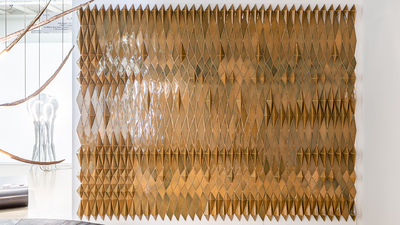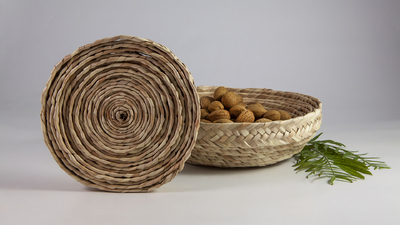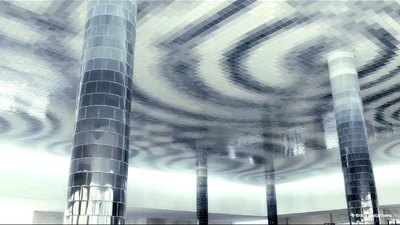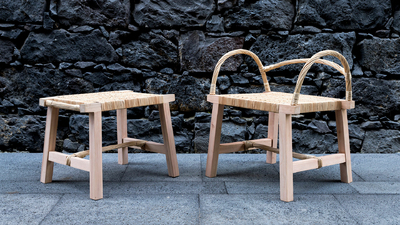Manufactum
The excellence of manufacture and savoir-faire in traditional techniques promote the historical and immaterial legacy of the Portuguese cultural heritage of arts and crafts and dignify the mission of the Ricardo do Espírito Santo Silva Foundation as a space for artistic creation and generational transmission. In current times, it is strategically necessary to continue the interlacement of traditional techniques and materials with contemporary artistic innovation, creating and reinventing new objects and new decorative concepts, contributing to the promotion, dialogue and connection of craftsmen, artists and designers. The objects here presented are a result from this fruitful dialogue and challenges to traditional manufacturing.
From Filipe Alarcão, a collection of pieces inspired by traditional Portuguese furniture models whose tradition is reinvented: desk and chair, cabinet on stand and a chest of drawers.
From Emmanuel Babled, Marre Moerel, Marco Sousa Santos and Sam Baron, pieces in the framework of the Reimagine Decorative Arts residences carried out in partnership with Passa ao Futuro. A residency that connects national and international established designers in collaborative structures with the highly skilled FRESS crafstman and technicians, in order to reinterpret traditional manufacture techniques into contemporary pieces through the methodologies of research and the exchange of knowledge.
All designs were driven and inspired by the workshops savoir-faire, the FRESS archives, the Museum collection and explorations of cultural heritage sources for inspiration such the use of natural materials within which the pieces were developed in the workshops: woods, leather and metals.
This strategy aims at an innovative creative and artistic concept directed towards a new taste - a contemporary take that is fundamental to the patrimonial approach of our manufacture.
Realization and Production: Fundação Ricardo do Espírito Santo Silva
Partnership: Passa ao Futuro
BEVERLY
Emmanuel Babled with Pedro Doria And David Cruz
Beverly was born out of the collaboration with the Portuguese foundation FRESS - which protects and promotes Portuguese decorative arts and handicrafts. Handcrafted from different woods, including brown smoked oak, walnut, zebrano and palisander, this organic chest features a hand-carved unique surface design and suggests a mystery to be solved. The chest has no front or back, no openings or visible handles, no planed surfaces: an invitation to discover and experience its shape. The mystery will eventually be solved, to include a further hidden storage compartment behind two cabinet doors. The two polished copper plates on the side create the illusion of spaciousness, depth and infinity. Four fine legs made of copper give this cabinet a fresh and sleek look. BEVERLY is available in additional styles, sizes and finishes.
LA GRAÇA
Marre Moerel with Miguel Alonso
A hung sculpture in space as an identity beyond the function. La Graca was Inspired by the enormous wooden carved candleholder in the Graca church in Lisbon. Taking a single detail of the immaculately carved candelabra to celebrate the master carving technique and craftsmanship, while at the same time addressing religion and the repression of old hierarchy of politics with contemporary minimalism. Shining a light on the beautiful craft illuminating and highlighting from within by simple subtle lighting, marrying old techniques with new LED technologies.
CAMA DE ÓPIO - OPIUM BED
Marco Sousa Santos with Teresa Romão and Beatriz Canha
The Opium Bed is an elegy for contemplation. As a representation of a bed, with no apparent comfort, the smooth curve of the surface provides the necessary ergonomics for a “contemplative” bed. With or without the use of artificial stimuli, in Opium’s bed we forget our bodies and “paradise” feeds on our spirituality.
Made of a metal lacquered iron frame and hand pressed bolted leather interlaced strips.
FEUILLADE
Sam Baron with António Almeida and Clara Sales
The collection is made of 3 pieces, a wall mounted lamp, a floor lamp (existing also in a ceiling version) and a mirror. All of them are based on a contrast between minimal structure and ornamentation, having as mere reference the lanterns made by the latoaria workshop. Sam re-processed the same recipe as the traditional lanterns in a very contemporary way and with a subtle interaction with the light source. From a simple volume these traditional light(ing) objects become impressive, thanks to the different typologies and quantity of leaves that are applied on them. The richness and diversity of the different beautiful drawings and templates of the leaves in the FRESS collection were used as patterns to create shadows while the light objects were lit. Gold leaf is then applied on the entire piece to give uniformity to both structure and ornament, giving them a strong presence in the home where they will be placed. This final touch is also assumed as a way to highlight and enrich a humble material such as cut metal sheets that without the human care and attention would never achieve such “almost-glamorous” state.
CONTADOR / CABINET
Filipe Alarcão
The Cabinet is in some way the result of careful observations about the particular features of FRESS, seeking to incorporate in this piece different technical skills that characterizes this institution, as well as the result of a reflection on the typologies of furniture that are produced. This object incorporates a series of elements and techniques that are present in many pieces produced in FRESS over time - woodworking, carving, inlaying, metalworking - as well as the use of small and intelligent mechanical devices which allow the incorporation of mechanisms of movement, concealment and closure. The design of this object thus consists in the creation of a cabinet, of non-specific use, closed by a system of doors that is totally reversible. Mounted on a system of metal surrounds with rotating pivots, this system allows to “dress” the furniture with two different decorations, thus allowing to completely change its visual appearance. In order to characterize this double-face effect, the design of two distinct decorations was chosen: a geometric decoration very minimalist and a more figurative decoration that recovers a carved floral motif, found in other Foundation’s pieces.



























































































